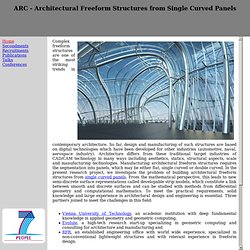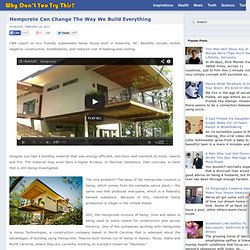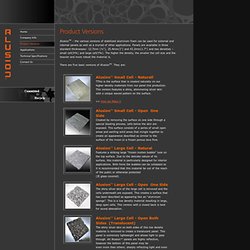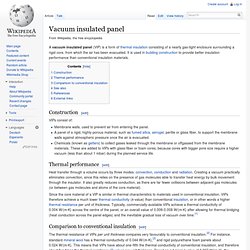

Building Products. Discovery of material with amazing properties. YouTube. ARC - Architectural Freeform Structures from Single Curved Panels. Complex freeform structures are one of the most striking trends in contemporary architecture.

So far, design and manufacturing of such structures are based on digital technologies which have been developed for other industries (automotive, naval, aerospace industry). Architecture differs from these traditional target industries of CAD/CAM technology in many ways including aesthetics, statics, structural aspects, scale and manufacturing technologies. Manufacturing architectural freeform structures requires the segmentation into panels, which may be either flat, single curved or double curved.
In the present research project, we investigate the problem of building architectural freeform structures from single curved panels. MATERIALECOLOGY: Neri Oxman. I Didn't Know That: Concrete Tent. Hempcrete Can Change The Way We Build Everything ~ Why Don't You Try This? CNN report on eco friendly sustainable hemp house built in Asheville, NC.

Benefits include carbon negative construction, breathability, and reduced cost of heating and cooling. Imagine you had a building material that was energy-efficient, non-toxic and resistant to mold, insects and fire. The material may even have a higher R-value, or thermal resistance, than concrete, a claim that is still being investigated. The only problem? The base of the Hempcrete creation is hemp, which comes from the cannabis sativa plant -- the same one that produces marijuana, which is a federally banned substance. Still, the Hempcrete mixture of hemp, lime and water is being used to some extent for construction jobs across America. Throughout Europe, the use of hemp for construction purposes has spread across many countries.
Seeing Hempcrete as a more efficient and sustainable building material has led to some dubbing it as a gateway product. Source: Huffington Post. Foamed Concrete and Lightweight Concrete. Materialise. Organic User Interfaces. CYMAT. ERG Duocel® – Reticulated Carbon, Ceramic, & Metal Foam. Features. AlusionTM – the various versions of stabilized aluminum foam can be used for external and internal panels as well as a myriad of other applications.

Panels are available in three standard thicknesses– 12.7mm (½"), 25.4mm(1") and 43.2mm(1.7") and two densities – small cell(X%) and large cell(Y%). The higher the density, the smaller the cell size and the heavier and more robust the material is. There are five basic versions of AlusionTM. They are: AlusionTM SAF has been used in the following applications: • Wall Cladding • Showroom Displays • Restaurants and Bars • Offices and Apartment Buildings • Ceiling Tiles • Flooring • Signs • Lighting • Fixtures • Exhibits View how some of our clients have used AlusionTM SAF with amazing results >>> To find out about using various combinations of AlusionTM, please see the Material Options chart in Technical Specifications.
Photovoltaic Cells. Devices which produce electricity directly from sunlight are called photovoltaic cells.

Efficiency of photovoltaic cells is universally acknowledged. Let us get acquainted with more of photovoltaic solar cells... If Physics amuses you, you must be knowing that photovoltaic (PV) cells are a phenomenal creation by man that have immensely contributed to saving global resources. In simple terms, photovoltaic cells are nothing but a cluster of cells put together, forming a solar panel, converting sunlight into electricity. Energy is created when the photons present in the sunlight take up electrons into a rather higher level of energy. Photovoltaic Cells: What are They Made of? Photovoltaic cells are made up of layered materials that are inclusive of two types of silicon; crystalline or amorphous. Photovoltaic cells are inclusive of one or more electric fields which create a certain kind of path for the tossed-off electrons in the form of a current.
Airloy Ultramaterials: Strong Aerogels from Aerogel Technologies. Vacuum insulated panel. A vacuum insulated panel (VIP) is a form of thermal insulation consisting of a nearly gas-tight enclosure surrounding a rigid core, from which the air has been evacuated.

It is used in building construction to provide better insulation performance than conventional insulation materials. Construction[edit] VIPs consist of: Membrane walls, used to prevent air from entering the panel.A panel of a rigid, highly-porous material, such as fumed silica, aerogel, perlite or glass fiber, to support the membrane walls against atmospheric pressure once the air is evacuated.Chemicals (known as getters) to collect gases leaked through the membrane or offgassed from the membrane materials. These are added to VIPs with glass-fiber or foam cores, because cores with bigger pore size require a higher vacuum (less than about 1 mbar) during the planned service life.
Thermal performance[edit] Comparison to conventional insulation[edit] See also[edit] References[edit] External links[edit] Www.vip-bau.de - evacuated insulation in building. Www.vip-bau.de - evacuated insulation in building. Www.emanate.org. Welcome - Bare Conductive.